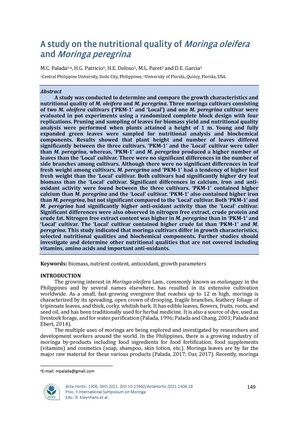Показать сокращенную информацию
Biomass yield of Moringa oleifera as influenced by plant density and harvest frequency
| dc.contributor.author | Patricio, Hope G. | |
| dc.contributor.author | Palada, Manuel C. | |
| dc.contributor.author | Deloso, Homer E. | |
| dc.contributor.author | Garcia, D. E. | |
| dc.date.accessioned | 2022-06-29T05:12:52Z | |
| dc.date.available | 2022-06-29T05:12:52Z | |
| dc.date.issued | 2017-05-09 | |
| dc.identifier.citation | Patricio, H. G., Palada, M. C., Deloso, H. E., & Garcia, D. E. (2017). Biomass yield of Moringa oleifera as influenced by plant density and harvest frequency. In Ebert, A.W. & Palada, M.C. (Eds.), I International Symposium on Moringa 1158 (pp. 97-103). International Society for Horticultural Science. https://doi.org/10.17660/ActaHortic.2017.1158.12 | en_US |
| dc.identifier.isbn | 978-94-62611-55-9 | |
| dc.identifier.issn | 0567-7572 | |
| dc.identifier.uri | https://hdl.handle.net/20.500.12852/2115 | |
| dc.description | Conference paper | en_US |
| dc.description.abstract | This study was conducted to determine the leaf biomass of moringa as influenced by plant density and frequency of pruning. Moringa plants were grown at four plant spacings and densities: a) 1×1 m (10,000 plants ha-1 - pph); b) 1×0.5 m (20,000 pph); c) 0.9×0.37 m (30,000 pph) and d) 0.5×0.5 m (40,000 pph), and harvested at three frequencies: 4, 6, and 8 weeks after first pruning for all treatments. The field trial was established and evaluated in a factorial randomized block design with three replications. Moringa seeds of cultivar 'PKM-1' were directly sown in various plots on December 12, 2013. Furrow and sprinkler irrigation were applied once per week to maintain optimum soil moisture for germination and seedling growth. Triple 14 fertilizer was applied at the rate of one tablespoon per plant three weeks after emergence. Seed germination was recorded 10 days after sowing and plant height was measured on a periodic basis. Initial pruning for all treatments was performed to a height of 1 m when plants reached 2 m at 116 days after sowing. Thereafter, harvesting frequencies were followed according to treatments. Results on leaf biomass indicated no increasing trend in leaf fresh biomass with increasing plant density except at 8-week harvest frequency. Highest fresh biomass of 30 t ha-1 was obtained from 40,000 pph harvested at 8-week interval. The lowest fresh leaf biomass was obtained at 10,000 pph. Data on fresh leaf biomass from plants harvested at 4- and 6-week interval at high density (40,000 pph) suggest that these treatments are optimum when there is a monthly demand for fresh raw materials for leaf processing into moringa by-product. | en_US |
| dc.language.iso | en | en_US |
| dc.publisher | International Society for Horticultural Science | en_US |
| dc.relation.ispartofseries | ISHS Acta Horticulturae;1158 | en |
| dc.subject.lcsh | Moringa oleifera | en_US |
| dc.subject.lcsh | Moringa oleifera--Yields | en_US |
| dc.subject.lcsh | Moringa | en_US |
| dc.subject.lcsh | Moringa--Yields | en_US |
| dc.subject.lcsh | Crop yields | en_US |
| dc.subject.lcsh | Plant spacing | en_US |
| dc.subject.lcsh | Harvesting | en_US |
| dc.subject.lcsh | Biomass | en_US |
| dc.title | Biomass yield of Moringa oleifera as influenced by plant density and harvest frequency | en_US |
| dc.type | Conference paper | en_US |
| dcterms.accessRights | Limited public access | en_US |
| dc.citation.firstpage | 97 | en_US |
| dc.citation.lastpage | 103 | en_US |
| local.subject | Drumstick tree | en_US |
| local.subject | Leaf biomass | en_US |
| local.subject | Plant spacing | en_US |
| local.subject | Plant population density | en_US |
| local.subject | Harvest frequency | en_US |
| local.subject.scientificname | Moringa oleifera | en_US |
| dc.identifier.doi | 10.17660/ActaHortic.2017.1158.12 | |
| dc.citation.conferencetitle | I International Symposium on Moringa | en_US |
| dc.identifier.essn | 2406-6168 |
Файлы в этом документе
| Файл | Размер | Формат | Просмотр |
|---|---|---|---|
|
В этом документе нет ни одного файла. |
|||




